NSC 3361 - Sleep and Circadian Rhythm Notes
1/91
Earn XP
Description and Tags
UTD NSC 3361 -> Sleep and Circadian Rhythm Notes
Name | Mastery | Learn | Test | Matching | Spaced |
|---|
No study sessions yet.
92 Terms
What strategies can improve sleep, as suggested in the lecture?
Improving sleep can involve fixing a bedtime, avoiding naps, avoiding alcohol and caffeine before bed, eating a light snack, and establishing a pre-sleep ritual.
Patient Case: George
10th grade = goes to sleep later and later each night
After graduation; his achievements were shown to be lower than his potential
Now as a uni prof. he sleeps from 5 AM to 1 AM
Medications he’s tried:
→ sleeping pills, anti-anxiety meds, psychotherapy = did not help
What is George’s Diagnosis? What medication was given (that worked)
Delayed Sleep-Phase Syndrome; was given melatonin (adjusted within 6 weeks)
T/F Sleeping helps clear out waste products in the brain (if so, WHICH ONES?)
True; beta-amyloid (causes Alzeihmers)
Why is adenosine important for rhythmic sleep?
promotes sleep by decreasing during the night (energy use diminishes = makes us tired)
In short- it’s from energy use of ATP during the day
How does adenosine affect the sleep cycle?
notice how adenosine levels decrease during the night
promotes sleep
= then resets and restarts the cycle
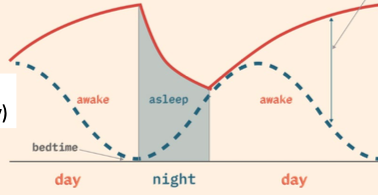
Diurnal
active during the day
Nocturnal
active during the dark
How long does the circadian rhythm last?
24 biological clock (endogenous- internal- clock)
Stimuli like ___, ____, and the ____ entrain us to be awake or asleep
lights, alarm clocks, moon
How do these stimuli allow us to be awake?
Sunlight, alarm clocks, and other stimuli related to waking up allow the body to INCREASE THE AMOUNT OF ADENOSINE = WAKE UP
What is the SCN important for?
“light on/light off” function
→ timing and consolidation for the sleep-wake cycle (regulate the timing of melatonin influx) = induction for sleep
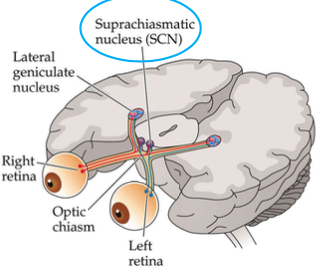
Light information goes from eye to SCN via ____ ___
retinohypothalamic path
visual pathway in X shape → retina to the brain (hypothalamus)
all determined by LIGHT
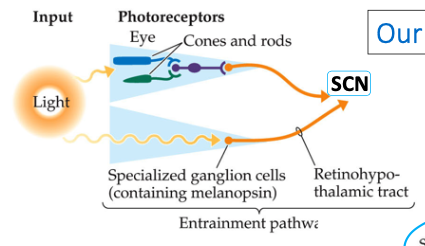
How does the 24 hour clock work?
CLOCK/BMAL promotes transcription of Period (PER) and Cryptochrome (CRY) genes → more PER and CRY protein
PER/CRY dimers build up → inhibit transcription of their genes
PER and CRY are degraded in a few hours, which lowers inhibition of their transcription, so after 24 hrs, a new cycle begins

How is the SCN involved in the 24-hour clock?
binds with BMAL and CLOCK proteins
works as the “master clock”
→ to generate circadian rhythms by regulating the transcription of various clock genes
T/F the 24-hour sleep cycle is a positive feedback
F - it’s a negative feedback because prolonged wakefulness inhibits wakefulness and promotes sleep
T/F is the sleep cycle always on time (happens at the same time everyday)?
F - slightly off each time; messes up the circadian rhythm sleep schedule
What effects occur to those who take cancer medication during the morning
Works better than when taking it at night
What happens when the SCN releases melatonin but you don’t sleep
inhibits sleep and cognition → makes it worse
What type of fuel is used for the metabolic pathway
Triglyceride
Note: during the night, this is then stored into STORED FAT
Brain and body function is ___ independent of the time of day
brain and body function is not independent of the time of day
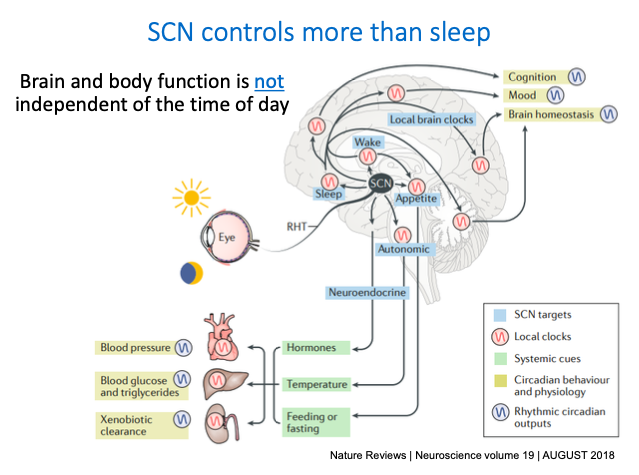
Lesions of the SCN
disrupts circadian rhythms
impacts the regulation of the pineal gland’s secretion of melatonin
SCN lesions do not abolish other rhythms
Mice: clock/clock mutation lose free-running circadian rhythms = NOT THOSE LESSER/GREATER THAN 24 HRS
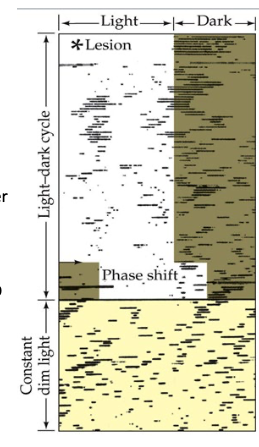
What occurs when someone takes naps and cannot sleep at night?
SCN slowly stops working
may not affect everything, but can affect other portions of rhythms:
→ clock molecules = every cellular body
Light/Dark Lesions
Dark = can’t mimic normal activities
Light = once its dawn, circadian rhythms shift
Why is it that melatonin is suppressed in the morning
Light resets the clock
What happens when the endogenous clock works without cues?
can’t tell the difference btw night and day
circadian rhythm changes
humans approx. 24 hrs (goes a bit faster) → completely shifts
How much time is needed to adjust into another circadian rhythm
TWO WEEKS NEEDED TO SHIFT CYCLE
How long does the avg human free-run cycle last
24 hrs and 11 min
How long does it take for babies to develop a circadian rhythm cycle?
8-16 weeks
By the first 2 months, the sleep cycle is inconsistent
By the 4th month, they start sleeping throughout the night
How does the sleep cycle for a teen differ?
teen boys tend to “stay up late, wake up late” (yes, more than girls)
BIOLOGICAL REASON FOR THIS?
→ would raid villages and consistent acts to maintain power
children and adults tend to sleep early and wake up early
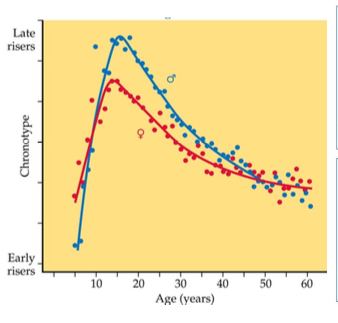
Our Daily Cycle
9:00 pm → release melatonin (dim-light melatonin onset); HITS ITS PEAK AT MIDNIGHT
4 am-7am → Surge of cortisol = more likely to get a MI
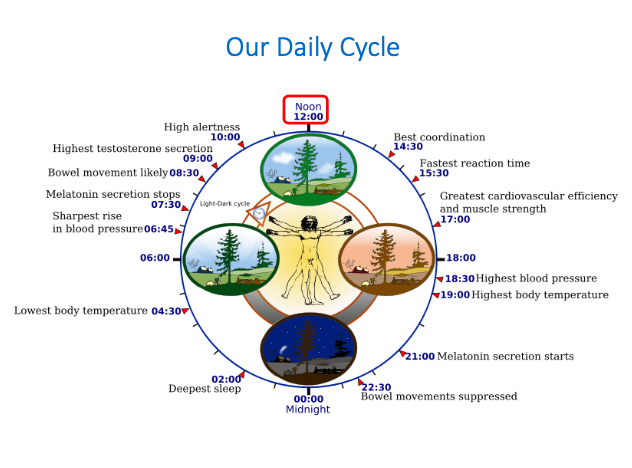
Our Diurnal Cycle
Stage 1: Daylight
increasing light signals the body clock to begin its active cycle. The body responds by producing serotonin, adrenaline, and cortisol.
→ Serotonin causes us to wake up, cortisol wakes us up fully
As the morning wears on, the body clock causes cortisol levels to drop but increases adrenaline and serotonin.
Stage 2: Daytime
By mid-afternoon, the body’s metabolism peaks; exercise and physical activity are best done now, as the body is most efficient at converting fat into energy. High-fat/calorie meals are best eaten at midday.
Stage 3: Evening
As daylight fades, the body clock cuts back on energetic hormones and we begin to wind down. As daylight drops pineal gland converts serotonin into melatonin (Dim Light Melatonin Onset), and we become lethargic. As melatonin and other sleep hormones increase our temp drops
Stage 4: Nighttime and Sleep Onset
Approx. 2 hours after DLMO, melatonin floods the bloodstream, making it more difficult to stay awake. This is the easiest time to fall asleep; in an hour, the release of melatonin will slow down.
Stage 5: Twilight and Awakening
Melatonin is released until the body clock perceives an increase in light. As darkness fades, the body stops producing melatonin, an hour before awakening; the Body Temperature Minimum is now. The active cycle starts again, with the release of cortisol.
Two types of Sleep
N1-3
(AKA slow-wave sleep, nonREM, Stages 1-4; Slow-wave EEG activity
→ brainwaves start shutting down
REM
rapid eye movements
breathing and HR speed up
muscle relax
→ stressful time in the brain
→ brain is still awake
-> brain is quite literally paralyzed (some parts)
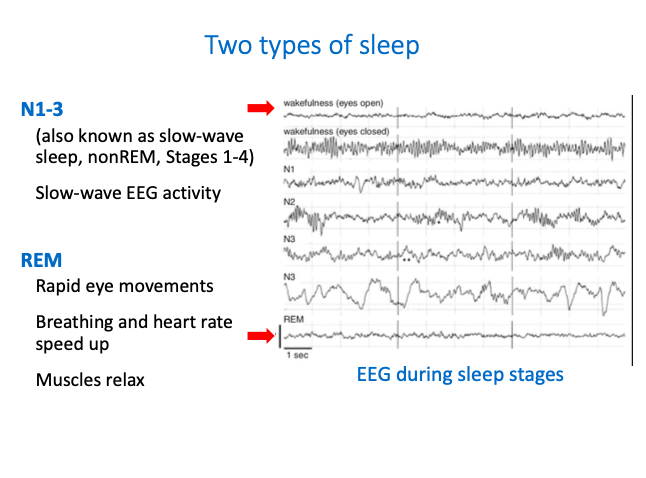
Typical Night of Sleep in a Young Adult
Cycle lasts 90-110 min
Cycles early in the night have more deep sleep; later cycles have more REM sleep
→ deep sleep for approx. 2 hrs; first half = deep sleep, second half = dream sleep (part of sleep cycle)
→ deep sleep usually occurs after an hour and a half of the sleep cycle
Which state do we usually dream in (REM or N; or even both?)
REM and N, but REM sleep is where we have more vivid dreams (visual imagery + sense that dreamer is there) = mostly negative dreams
→ N Sleep is responsible for brief fragmented dreams that are less emotional and visual
Lucid Dreaming
Lucid dreaming is a state of consciousness where the dreamer becomes aware that they are dreaming.
What type of sleep increases the chances of having nightmares?
REM Sleep
Nightmares
Nightmares are frightening dreams that occur during REM sleep, often characterized by vivid imagery and a strong sense of fear or anxiety.
Night Terrors
Night terrors are episodes of intense fear and panic that occur during non-REM sleep, specifically during stage N3 (deep sleep)
Do animals have REM Sleep and if they do/don’t, why?
Marine animals DO NOT HAVE REM SLEEP => relaxed muscles are incompatible with the need to surface to breathe
Animals like birds and dolphins => one hem. enters in SWS (other does not)
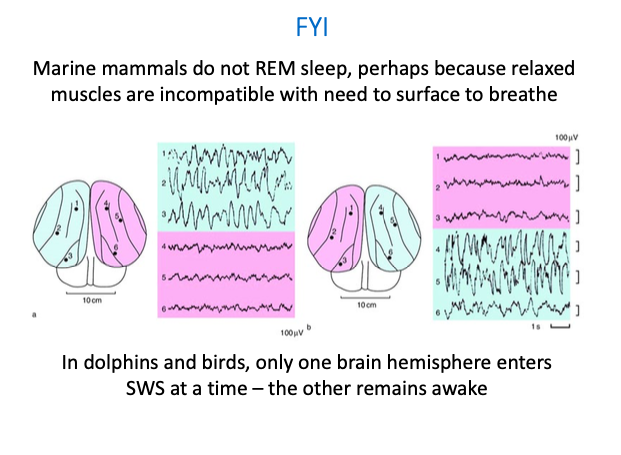
What age are night terrors most common?
1 ½ years to 5 years
As we age, total time asleep ____ and awakenings ___
declines, increases
Do babies tend to get more or less REM sleep?
More REM Sleep → it's important for their brain development + memory formation + process learnt information
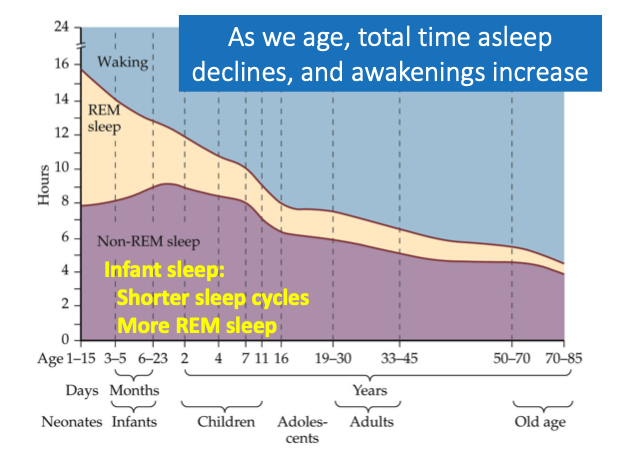
How does the brain wake up after a SWS cycle
SCN (suprachiasmatic nucleus) turns off inhibition of the brainstem reticular activating system, which turns on the cortex via the thalamus
How does the brain fall asleep?
VLPO nucleus of hypothalamus turns off the brainstem
List what each of these nucleus release?
LC → locus coeruleus - NE
VTA → ventral tegmental area - dopamine
Raphe → S5
What part of the brain controls sleep/wake state?
Brainstem → pons; ( cortex afterwards is responsible)
What part of the brain functions as an “offswitch” for the brain
hypothalamus → regulate whether we should sleep (specifically the VLPO nucleus)
What happens if we don’t follow the steps for VLPO nucleus (hypothalamus)
leads to fatal insomnia
1) neuron in pons produce acetylcholine → activates thalamus
2) stimulates cerebral cortex → site of consciousness
3) Neurotransmitters noradrenaline, serotonin, histamine, and dopamine = produced in pons, hypothalamus
4) nearby regions prime CEREBRAL CORTEX to receive signals from the thalamus
5) neurotransmitters in the lateral hypothalamus reinforce the arousal system
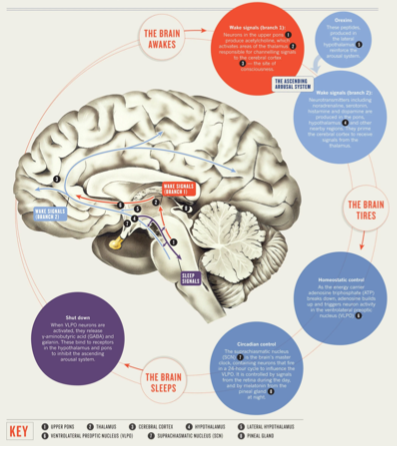
How many nights does it take to process certain memories
43 nights → elimination process
What is the limbic system responsible for during dreaming?
emotional aspect
What is the hippocampus responsible for during dreaming?
memory
REM is an active brain state
Ascending upper brainstem system - activates cortex
Descending pons system - triggers REM; paralyzes body
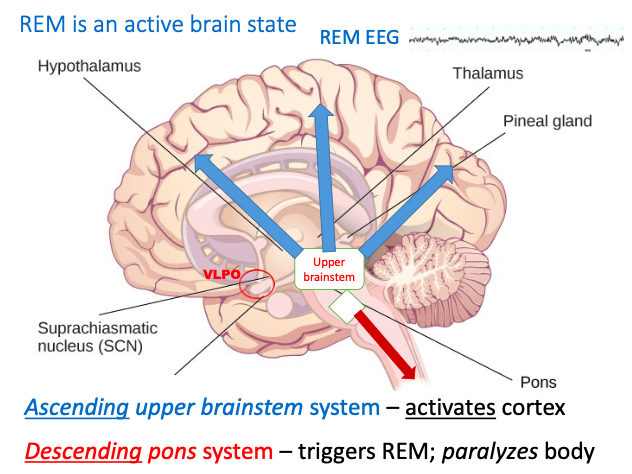
What’s the main difference btw N Sleep and REM Sleep?
N sleep we recall (replay) and in REM sleep we consolidate
Why might taking a nap be a good idea?
60-90 min nap contains REM and non-REM sleep improves learning
- REM sleep increases following learning
REM deprivation after learning reduces retention
Replay of learned material is sync. with ____
Hippocampus
→ days later, memories become independent of the hippocampus
MEMORY ERASURE - brain purges unwanted memories during REM sleep
What happens to the hippocampus, limbic system, and frontal cortex during REM Sleep and Memory?
Hippocampus and limbic system are in overdrive; and the frontal cortex shuts down
Impact of sleep deprivation (partial or total)
increased irritability
difficulty in concentrating
episodes of disorientation
effects worsen with age
What was the name of the student who stayed awake for more than 502 hours? (21 days)
Jonathan Daley
Narcolepsy
frequent sleep attacks, but insomnia and excessive daytime sleepiness
Do not go through N before REM sleep
Cataplexy → sudden loss of muscle tone and collapse (Zach)
“brain does the right thing, at the wrong time”
abnormal brain architecture
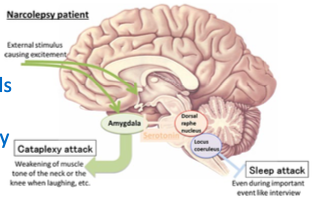
Who is Zach?
Individual that was in the video about narcolepsy
What happens to the brain during a narcoleptic attack?
dorsal raphe fails to inhibit the amygdala from activating the LC = cataplexy
What type of mutant receptor do narcoleptic dogs have in their brainstem?
Orexin
Orexin
prevents transition from wakefulness directly into REM sleep
released when you wake up
In narcoleptic ppl there is autoimmune attack on orexin receptor
Also important for appetite, motor activation, vigilance
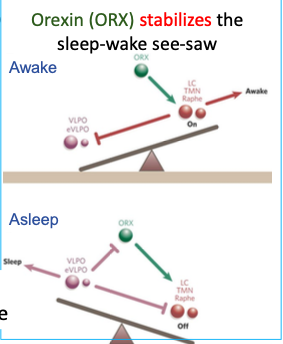
Sleep Paralysis
brief inability to move just before falling asleep, or just after waking; pontine center (imp in muscle movement) triggers muscle relaxation
What is the correlation btw narcolepsy and sleep paralysis?
someone who has sleep paralysis has increased chances of having narcolepsy
What two conditions specifically happen during N sleep?
night terrors and enuresis
Somnambulism (sleepwalking)
occurs during N sleep => persists through adulthood
Characterized by walking or performing other complex behaviors while in deep sleep (NREM sleep). It often occurs during the early part of the night, in the N3 stage of sleep, and can persist into adulthood.
Sleep Apnea
breathing stops (apnea) => blood oxygen drops rapidly
chest/diaphragm muscles => relax too much or pacemaker respiratory neurons in brain stem do not signal properly
accompanied with snoring/gasping
apnea => arouses breathing => daytime sleepiness
EEG of Sleep Apnea Patients
In sleep apnea patients, the EEG shows disrupted sleep patterns characterized by frequent arousals during sleep. These arousals are associated with episodes of apnea, where breathing temporarily stops, leading to sudden awakenings.
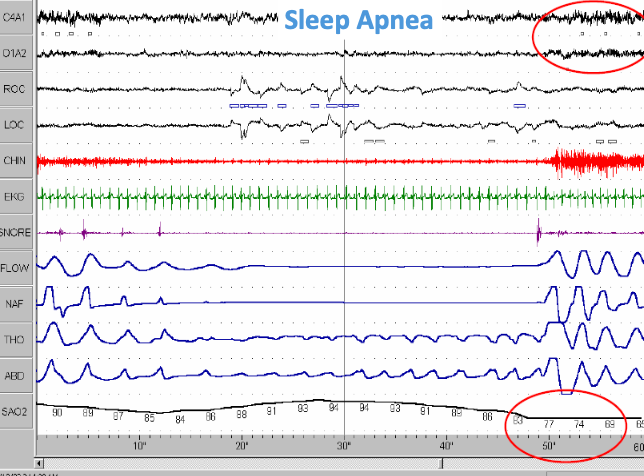
What is sleep myoclonus?
Sleep myoclonus is a sudden jerk or twitch of a muscle or a group of muscles that occurs during sleep.
How does sleep myoclonus differ from sleep apnea?
Unlike sleep apnea, which involves episodes of breathing cessation, sleep myoclonus involves involuntary muscle contractions during sleep without interruptions in breathing.
What impact can sleep myoclonus have on sleep quality?
Sleep myoclonus can disrupt the sleep cycle and lead to fragmented sleep, potentially reducing overall sleep quality.
How is sleep apnea treated
CPAP - continuous positive airway pressure
→ prevent collapse of the airways; untreated sleep apnea leads to fatal MI
What age is commonly affected by sleep myoclonus
infants- usually disappears by 6 months
What type of test is used in order to identify sleep apnea?
Overnight polysomnogram (PSG)
Which individual was diagnosed with sleep apnea
Prince Fielder
What part of the brain is on overdrive during night terrors?
limbic system (emotions) → takes time for brain architecture to process
How long do night terrors usually last? Do you outgrow them?
Average age spans from 2-5 years, NOT IN ADULTS
Why is it that sleep apnea has a mortality rate?
Once they stop breathing = brain and heart become compromised
minor injuries that cumulate to larger ones
SIDS
sleep apnea from immature respiratory pacemakers or arousal mechanism
What is Ondine's Curse?
Ondine's Curse, also known as congenital central hypoventilation syndrome (CCHS), is a condition where a person lacks automatic control of breathing, particularly during sleep. Individuals with Ondine's Curse must consciously breathe, and they may not respond to low oxygen or high carbon dioxide levels, leading to potential respiratory failure.
How is Ondine's Curse related to Sudden Infant Death Syndrome (SIDS)?
Both Ondine's Curse and SIDS can involve issues with respiratory control. In SIDS, it is thought that sleep apnea may occur due to immature respiratory pacemakers or an ineffective arousal mechanism, which can compromise breathing during sleep and may be related to risk factors associated with Ondine's Curse in infants.
How to prevent SIDS
put babies to sleep on their backs can prevent suffocation due to apnea
A = alone
B = on my back
C = in my crib
REM sleep behavior disorder
paralysis that normally occurs during REM sleep is incomplete or absent
“act’s out in dreams” → usually violent, intense, and vivid
Ex: talking, yelling, punching, kicking, jumping from bed
What percent of individuals with RBD have some form of violent outburst?
32% patients injure themselves
64% assault their spouse
Dreams involve the sleeper’s defense against attack in 87%
Case Study: Kenneth Parks
Kenneth Parks sleepwalked to attack his in-laws, stabbing his mother-in-law and strangling his father-in-law. He had no memory of the event and was acquitted due to his history of sleepwalking and severe sleep deprivation.
George - continuation
began 5 mg melatonin/3 hours before bed
gradually advanced as his bedtime advanced
6 weeks reached = perfect bed time (or so he says)
melatonin at 9PM, bedtime. at midnight, wake-time at 8-9AM
_____ - Alzheimers proteins are cleared from brain during sleep
Amyloid proteins are drained by the lymphatic system during sleep, which helps maintain brain health and prevent neurodegenerative diseases.

What strategies can improve sleep?
Fix a bedtime and awakening time, avoid naps, avoid alcohol and caffeine 4-6 hours before bed, exercise regularly but not right before bed, have a light snack (like bananas), establish a pre-sleep ritual, and reserve the bed for sleep and sex only.